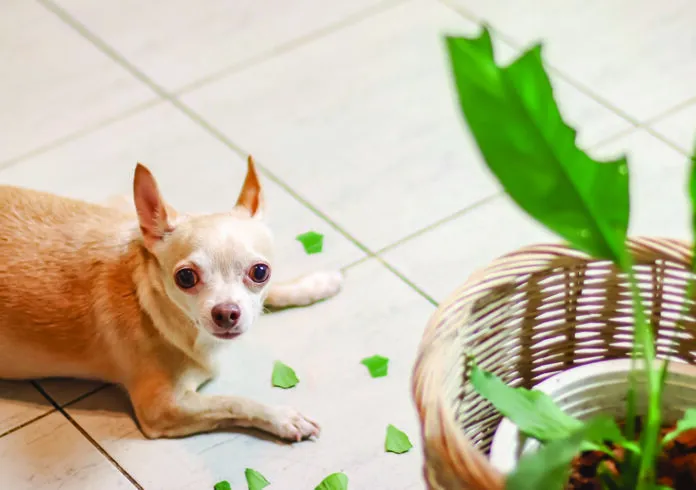
We love our trees, shrubs, flowers, and houseplants for good reason. They reduce our stress levels, improve our health, increase our connections to nature, and bring us hours of aesthetic appreciation. Unfortunately, some of our favorite plants can be dangerous to dogs, causing gastrointestinal distress, vision problems, confusion, organ failure, and even death.
What Are the Signs of Plant Poisoning in Dogs?
Symptoms of plant poisoning in dogs vary by plant, but in general, a plant that causes contact dermatitis will generate painful sores, especially in the mouth and mucous membranes.
The symptoms of poisoning when the dog ingests a plant are often more serious. They can include:
- Drowsiness
- Vomiting
- Diarrhea
- Lack of appetite
- Weakness
- Staggering
- Loss of balance
- Convulsions
- Coma
Plant poisoning requires rapid medical treatment. Depending on the plant, symptoms can appear anywhere from immediately after the dog eats the plant to several days later, so it’s best to get help as soon as you suspect your dog might have ingested—or even just chewed on—a potentially toxic plant.
What To Do If Your Dog Swallows a Poisonous Plant
If your dog eats a poisonous plant, check her breathing and overall appearance so you can provide an accurate description of your dog’s symptoms, including her weight.
Take notes about when and where the exposure occurred or when you noticed symptoms so you can describe the symptoms’ progression.
If you suspect a specific plant but don’t recognize it, take a photo or collect a sample of the plant to help with identification.
Save a sample of the dog’s vomit, if any.
Do NOT give your dog any home remedies such as milk, salt, or oil.
Do NOT induce vomiting without talking to your veterinarian or a poison control center. In some cases, vomiting may be detrimental.
Depending on your dog’s condition and the plant she ingested, your veterinarian might administer a liquid suspension of activated charcoal, which can absorb certain toxins. If appropriate, hydrogen peroxide or a similar substance can cause vomiting to help remove plant material from the dog’s stomach.
Intravenous fluids and medications may be necessary for more serious reactions. Techniques such as total plasma exchange and plasma absorption (using a specialized machine to remove toxins from the blood) may prevent fatal poisoning, such as from a toxic mushroom, if performed in time.
If you suspect your dog has swallowed a toxic plant, don’t wait to ask for professional advice. Keep your veterinarian’s phone number or local pet emergency clinic phone number handy and call for help as soon as you realize there’s a problem. If you can’t reach your vet, call one of the 24/7 information services below. These centers are staffed by veterinary professionals. Visit their websites for authoritative lists of toxic plants, their identification, and the symptoms they cause.
The ASPCA Poison Control Center. aspca.org/pet-care/animal-poison-control. (888) 426-4435. A consulting fee may apply.
The Pet Poison Helpline. petpoisonhelpline.com. (855) 764-7661. $75 fee.
Many more plants are listed as dangerous by various sources, though some warnings apply only to other species or include only minor effects. When in doubt, look for information from reliable sources, such as the poison control centers listed below.
Plants Poisonous to Dogs
If you study reports about plants that are toxic to dogs, the lists can seem endless. Even benign plants, like the beneficial herb chamomile or the stems and leaves of tomato, pepper, eggplant, or potato plants, can be harmful to dogs if they swallow enough. However, the following plants are of greater concern because they can cause a serious reaction, even if only small amounts are consumed:
- Oleander (Nerium oleander), which is also known as Nerium, is a tall, fragrant, ornamental shrub with rose, white, or yellow flowers. They grow in hardiness zones 8-11, and all parts are highly toxic to dogs. They contain cardiac glycosides, and signs of ingestion include weakness, drooling, abdominal pain, diarrhea, vomiting, cardiac arrhythmia, tremors, seizures, and death.
- Azaleas and rhododendrons (Rhododendron ) are fragrant, flowering shrubs that come in white, yellow, orange, pink, and red. Native to North America, they are found in hardiness zones 6-9. All parts of the plant are extremely poisonous to dogs because they contain grayanotoxin, which can cause vomiting, diarrhea, vision problems, and even coma or death.
- The sago palm (Cycas revoluta, zamia species) is a popular landscaping and houseplant that looks like a miniature palm tree. It grows outdoors in hardiness zones 8-10 but is often grown indoors as well. Every part of the shrub, especially the seed pods and nuts, contains a toxin called cycasin, which is so harmful that any part of the plant, including a single seed, can cause death. Symptoms of ingestion include increased thirst, decreased appetite, vomiting, bloody stools, jaundice, seizures, liver failure, and death.
- The autumn crocus (Colochicum autumnale), also called meadow saffron, is a member of the lily family is found in USDA Plant Hardiness Zones 6-10. All plant parts—bulbs, pink-purple flowers, and narrow, grass-like foliage—contain colchicine, which causes gastrointestinal bleeding, severe vomiting, kidney and liver damage, and respiratory failure. Symptoms may not develop for several days, so don’t delay veterinary attention if your dog swallows any part of this plant.
- Tulips (Tulipa /Narcissus spp.) are popular, winter-hardy, bell-shaped flowers found outdoors in hardiness zones 3-8 and often included in bouquets. All parts of the plant are harmful to dogs, with bulbs being the most toxic. Signs of ingestion include drooling, lethargy, loss of appetite, upset stomach, vomiting, dehydration, cardiac arrhythmias (irregular heartbeats), respiratory problems, convulsions, and death. Daffodil (Narcissus spp.), hyacinth (Hyacinthus orientalis), gladiolus (Gladiolus spp.), and amaryllis (Amaryllis spp.) bulbs, flowers, and leaves can cause similar symptoms when ingested by dogs.
- Holly leaves (American, English, Japanese, and Christmas varieties—Ilex opaca/Ilex aquifolium) can cause vomiting, diarrhea, drooling, lip smacking, head shaking, a swollen mouth and tongue, and difficulty breathing.
- Lily of the Valley (Convallaria majalis) is a sweet-smelling plant with delicate, white, bell-shaped flower clusters. Found in hardiness zones 3-9, the entire plant is moderately to severely poisonous to dogs with the main toxin being cardiac glycosides. Symptoms of ingestion include disorientation, vomiting, diarrhea, cardiac arrhythmia, seizures, and coma. Ingesting gloriosa (Gloriosa superba) can lead to similar symptoms while daylilies (Hemerocallis spp.), which are extremely toxic to cats (as are all lilies), cause only gastrointestinal upset in dogs.
- Pothos (Epipremnum aureum), also known as golden pothos or devil’s ivy, has arrow-shaped, variegated white, yellow, and green leaves. It is found outdoors in hardiness zone 10-12 but is often grown indoors as an easy-care houseplant. Mildly toxic to dogs, these plants contain insoluble calcium oxalate crystals in the roots, stems, and leaves that resemble sharp glass. Eating these plants can cause oral irritation, mouth swelling, respiratory problems, skin irritation, drooling, vomiting, trouble swallowing, and coughing. Plants including Elephant’s ear (Caladium hortulanum), English ivy (Hedera helix), plants in the philodendron family, calla lily (Zantedeschia aethiopica), peace lily (Spathiphyllum), and dumb cane (Dieffenbachia) also contain calcium oxalate crystals and cause similar symptoms when ingested by dogs.
- Castor bean/castor oil plants (Ricinus communis) are widespread throughout tropical areas. These highly toxic ornamental annuals have large leaves, bright flowers, and seed pods, all of which contain the highly poisonous toxic ricin. They thrive in hardiness zones 9-11. If your dog eats them, symptoms include appetite loss, excessive thirst, vomiting, diarrhea, tremors, seizures, trouble breathing, loss of coordination, coma, and death.
- Cyclamen (Cyclamen) is a petite, sweet-scented perennial flowering plant often grown indoors. Found in hardiness zones 9-11, these plants contain irritating terpenoid saponins, especially in the tubers, making them highly toxic to dogs. Poisoning symptoms include drooling, vomiting, diarrhea, cardiac arrhythmia, seizures, and death.
- Foxglove (Digitalis purpurea) is a tall plant with downward-facing, bell-shaped flowers and is found in hardiness zones 4-9. All parts of these plants, from the seeds to the petals, contain cardiac glycosides, which are extremely toxic to dogs. Signs of ingestion include weakness, vomiting, diarrhea, cardiac arrhythmia, and death.
- Yew (Taxus spp.) is an evergreen plant frequently used in holiday wreaths as well as being a popular shrub for landscaping across North America, with most growing in hardiness zones 3-8. All varieties contain the dangerous toxin, taxine, in the bright green leaves, red berries, seeds, and stems. Signs your dog has ingested some of this highly poisonous plant include lethargy, difficulty breathing, vomiting, tremors, seizures, heart and blood pressure changes, heart failure, and death.
- Mushrooms are a seasonal problem in some areas. While most of the world’s 10,000 mushroom species are harmless to dogs, some wild mushrooms can be fatal, even in small amounts. Clinical signs of mushroom toxicity include excessive salivation, vomiting, diarrhea, liver failure, tremors, and seizures.
For a list of more plants poisonous to dogs, see the ASPCA’s Toxic and Non-Toxic Plant List.
What Dogs Are at Risk of Ingesting Poisonous Plants?
Any dog can be drawn to a tree, flower, or houseplant that is potentially toxic, but at the top of the risk list are puppies who explore the world by sniffing, tasting, picking up, or swallowing whatever they encounter. Next are active dogs of any age, especially those who love to fetch sticks, dig in the dirt, or search everywhere for something edible.
Prevention is the Best Approach
It’s good to be organized, well informed, and ready to respond to emergencies, but preventing them in the first place is the best approach. Study the plants in your house and yard so you know which are potentially dangerous.
Move toxic houseplants out of your dog’s reach. If a plant is irresistible to your dog, use a pet gate or other obstacle to keep her from reaching it. If that doesn’t work, consider rehoming the plant.
Use positive reinforcement to reward your puppy for staying away from problem plants by focusing on his name and rewarding him for coming when called. The safest place for puppies and adolescent dogs when no one is home where there are potentially toxic house plants is in a crate.
Make house and garden plants unattractive to dogs by spraying them with lemon juice diluted with an equal amount of water. Reinforce the scent by placing lemon slices in plant pots or on the ground outdoors. Bitter Apple, Bitter Yuck, chili pepper sauce diluted with water, and other sprays that discourage chewing can be sprayed on and around harmful plants. Some trainers recommend sprinkling cayenne pepper powder around poisonous plants.
Chicken wire laid on the ground discourages digging. It can also be used to fence off sections of your yard. But the safest thing to do if you have a puppy or a dog who likes to dig or chew on plants is to remove toxic plants from your yard. And if you’re planning a garden, beginning a landscaping project, or deciding what plants to grow in your house, eliminate the risk and choose nontoxic dog-friendly species.







